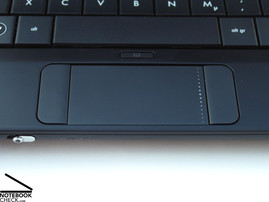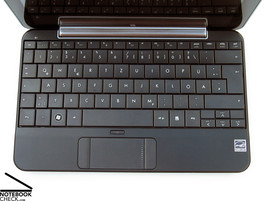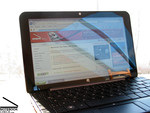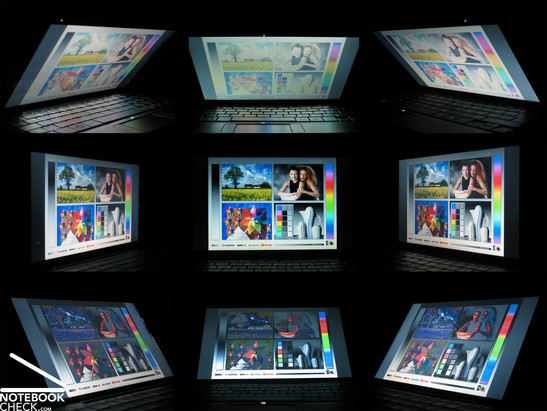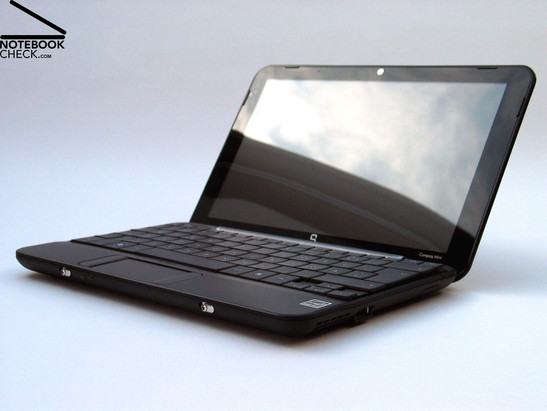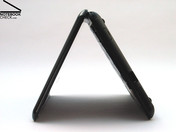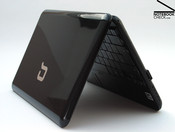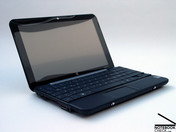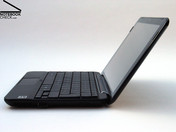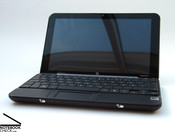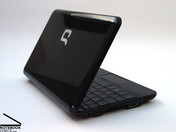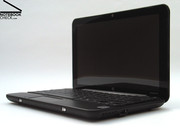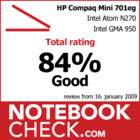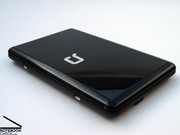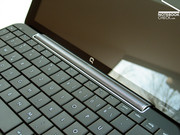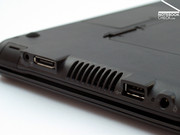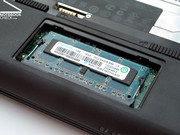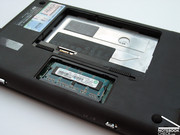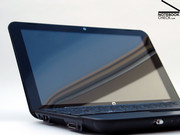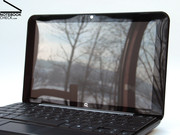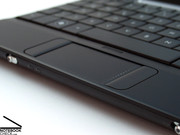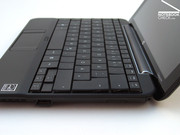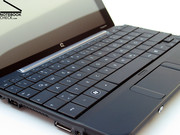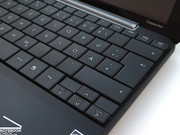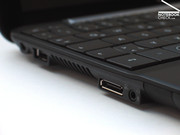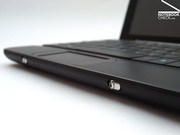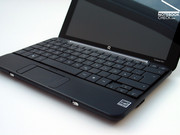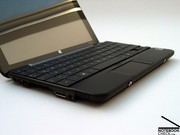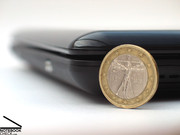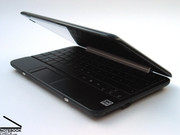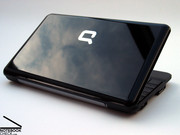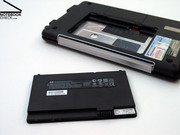Review HP Compaq Mini 701eg Netbook
Hoidy-Toidy.
Hoidy-toidy. If you are familiar with the term "netbook", the first thing you probably think of is the Asus Eee PC. Actually, there is a whole series of netbooks from other brands that also have their good qualities. For those who like well designed netbooks, the HP Compaq Mini 701eg should stand out in front of the crowd, since it looks, in comparison to some more clumsy colleagues, extremely good. How the chic netbook scored in an extensive review, you can read here.
HP's first step into the netbook market took the form of the Mini-Note 2133, which was still equipped with a Via C7 CPU. The 8.9 inch display was also typical for netbooks at that stage of development.
The current Compaq Mini 701eg Model, following the general trend, employs a larger 10 inch display. Interestingly, HP already recognized the necessity of an easily operable keyboard in its 8.9 inch model, and endowed the notebook with an appropriately large case, even despite the smaller display. The Mini 701eg, therefore, has extremely familiar case display components.
Case
Even though the case itself is fundamentally different from that of the Mini-Note 2133, there are still highly visible parallels to its predecessor in the design of the netbook. One of these is recognizable in the breadth of the case, which at 262 millimeters is practically the same as its predecessor. This allowed the keyboard that was already included in the 9-inch model, which in terms of netbook ratios is very generous, to be integrated in the device.
The general design is, with the exception of the wedge-shaped base unit, which is now built extremely flat and level, the same as the Mini-Note 2133. The rounded corners of the case, which has an otherwise absolutely planar surface, are also significant.
Two additional peculiarities in the design make the HP Mini 701 a head-turner: on the one hand, the display was furnished with a mirrored cover that was drawn over the viewable area up to the outer edges of the screen (meet the new Macbooks from Apple), and on the other hand, the central display hinge incorporates the netbook's speakers behind an eye-catching perforated metal cover. Visually, the HP Mini 701eg is hardly like any other current netbook.
As attractive as the central hinge is, the disadvantage of the preprogrammed limit to the opening angle should not be understated. In the case of the Mini 701 from HP, this is even of vital importance, in our opinion. The viewing position can be adapted up to the largest available angle of 123°. In the test, we were almost constantly afflicted by too bright of a picture when working on the desk because of the sub-optimal viewing angle.
The base unit is composed of a plastic case tray with cover made from metal material, probably aluminum. This combination makes a very good tactile impression, but slight deformations, especially on the underside of the device, can occur under pressure.
The display is dominated by mirrored high-gloss surfaces. As mentioned earlier, the front side of the screen was equipped with a totally flat and transparent high-gloss surface up to the outermost edge. The display cover is also adorned with a black high-gloss finish and has a discreet and thoroughly chic structure.
What is good for the eye, however, is often not necessarily practical in everyday use. The display hinges do allow the netbook to be lifted by the display without problems, but in most cases this leaves behind unattractive fingerprints on both the surface of the display as well as the display cover. HP is obviously conscious of this problem, and provides a cleaning cloth along with the netbook.
Well then, have fun polishing...
Another peculiarity must be mentioned along with the display: it lies noticeably against the keys of the netbook in the shut position. Because of this, one may want to save some sort of rubber stopper. The fact that the keys are often dirty and can therefore affect the display surface. HP also finds a way to help here by providing the netbook with a felt inlay. If one wants to avoid possible contamination of the display, one should also always use this during later transportation, or perhaps resort once more to a good old cleaning rag.
Connectivity
Netbook basics and then some — this is how you could describe the ports HP has offered on the Mini 701. The typical netbook connections include, without a doubt, both of the USB ports as well as the multimedia card reader. The audio ports offered seem unusually limited, if you will. There is only a single 3.5mm stereo jack on the left side of the case. What makes this especially confusing is that, next to it, there are both a microphone and a headphone logo.
This combined microphone input and audio output was installed purely for the reason of saving space. Connecting a standard headset with headphones and a microphone with it, however, is impossible, so you have to, with telephony for example, rely either on the integrated speakers for playback or else on the integrated microphone for sound pickup.
The expansion port offered is also interesting. According to the user handbook, despite the name, for the time being, apparently, it can only be used exclusively for the connection of an external VGA device, meaning a display or a projector. According to HP, an assortment of connections for this port are currently being worked on. In the future, even more functions might be supported.
The so-called “HP mobile drive” port on the right side of the case was locked by a plastic cover in our test sample. Here, as far as is available (model 702eg ?!), a USB 2.0 based fixed disk memory expansion can be implemented.
The state of the ports is not necessarily optimal, and expansion port and the LAN connection, which lies far to the front of the device, can cause some inconvenience because of the cables next to the notebook, especially during stationary use.
In terms of communication, the Mini 701eg offers an integrated Ethernet module from Marvell Yukon (10/100) and wireless LAN standard 802.11 b/g from Broadcom. A feature that is almost standard equipment for netbooks is an integrated bluetooth module, which enables communication with various small electronic devices (cell phone, Pocket PC,...).
Although a UMTS option for the HP Compaq Mini 701eg is to date not available (with the exception, of course, of an external UMTS expansion via USB), our test sample possessed an extremely suspicious opening on the inside of the battery chamber that “coincidentally” had exactly enough space for a sim-card. One could surmise from this that, at least at a later point in time and perhaps under another label (702eg ?!), a version with an integrated UMTS module will also be available.
With the warranty provided, the largest notebook manufacturer in the world, HP, does not drop the ball. For a total of 24 months, a manufacturer's warranty with pickup and delivery service is offered for the Mini 701.
Input Devices
As was already indicated above, the keyboard unit installed is apparently the same as was already employed in the 9 inch Mini-Note 2133. The characteristics of the keyboard, correspondingly, are identical. With a key size of 1.7 by 1.6 centimeters, it offers a size sufficient for hammering out longer texts without all too much trouble. You could easily employ the 10-finger system on it, which caused surprisingly few mistakes during the course of our test.
Some mistakes are possible, though, in the area of the left shift key and the cursor keys, all of which are small in comparison to the others. One thing we found very pleasant was the two-row enter key, which has already become a standard with the introduction of the 10 inch form factors.
The feeling while typing stands out due to a rather short and resilient keystroke length, however this was perceived as thoroughly pleasant during the test. The nearly planar surface of the keys takes some getting used to, in our opinion. The sounds produced by typing are totally normal, and the level of noise they produce during normal text input is always justifiable.
The touchpad on the front of the base unit was well designed. Because of the extremely small amount of space available, the touchpad buttons were put on the side of the pad. This certainly complicates any attempt to operate the touchpad with only one hand, but it is easy to manage using two hands.
You should be careful, however, that you don't touch the pad while pressing the keys and confuse the cursor. In the test, this unfortunately happened relatively often.
The button that deactivates the pad proved itself to be a thoroughly useful gadget. This can prevent undesired inputs from being sent through the pad during text input. However, the white LED light that marks the pad being active shines extremely brightly, and some users might find this very disturbing since it lies in the middle of the field of vision on the device.
Display
HP equipped its netbook with a 10.2 inch WSVGA display with LED lighting. With a Resolution of 1024x600 pixels, the viewing area and working surface are consistent with most netbook panels available on the market. Simple office applications manage thoroughly well on it, and you could definitely get by with web surfing. However, you have to adapt to the frequent vertical scrolling that is necessary for nearly all uses: a problem that the majority of current netbooks have to struggle with.
In our display brightness test, the installed display did very well. The maximum value of 223 cd/m² can be seen in the center of the display, but is put into perspective by the fact that the illumination level of the display was only 74%. The reason for this is a reduction in the brightness at the corners of down to 167.1 cd/m².
| |||||||||||||||||||||||||
Brightness Distribution: 75 %
Contrast: 117:1 (Black: 1.9 cd/m²)
Another point of critique for the LED panel is the surprisingly low contrast relationship. With a higher than average black value of 19 cd/m², the panel reaches a disappointing result of as little as 117:1 in this category.
But that is not enough. Another immensely important point, in our opinion, especially for netbooks, was not implemented by HP, contrary to the general trend in netbooks. The mirrored display surface, which is visually very appealing, but rather annoying during practical use makes operating the notebook out of doors possible only with major limitations. Additionally, the netbook lacked enough leniency in the opening angle of the display to minimize the reflections that appeared.
The display's ability to produce colorful images is, thanks to the brilliant surface, definitely above average. Problems arise, however, as soon as you can no longer maintain the optimal viewing angle perpendicular to the display.
Then, even at slight departures from the ideal vertical viewing angle, noticeable image distortions begin to appear. Horizontally, the greater struggle is with the reflections produced.
Performance
Current netbooks are extremely difficult, in fact nearly impossible, to compare in terms of the power available to them. Most of the devices possess an Intel Atom N270 PU with 1.6 GHz and an integrated Intel GMA 950 graphics chip based on the Intel 945GM chipset. Also in terms of RAM they are equipped with, the netbooks equal each other to a tee with a maximum one gigabyte of RAM.
Differences, therefore, can only be accounted for in the end by the fixed disk installed. The HP Compaq Mini 701eg employs a traditional 1.8 inch fixed disk with a rate of 4200 rpm and a total capacity of 60GB.
The results of the hard disk in the HDTune benchmark test show rather low transfer rates with a somewhat below average retrieval time of 19.5 milliseconds.
Like other comparable netbooks with identical hardware in terms of the CPU, graphics cards, and RAM, the Mini 701eg is also thoroughly suitable for everyday office applications. The main functions are probably limited predominantly to composing texts, displaying images, managing contacts and mail traffic, and using the internet. With the exception of somewhat longer waiting times now and then, no obvious limitations should arise.
| 3DMark 2001SE Standard | 3001 points | |
| 3DMark 03 Standard | 740 points | |
Help | ||
| Cinebench R10 | |||
| Settings | Value | ||
| Shading 32Bit | 274 Points | ||
| Rendering Multiple CPUs 32Bit | 838 Points | ||
| Rendering Single 32Bit | 545 Points | ||
Emissions
System Noise
While Dell apparently did everything correctly with their compact notebooks, the Dell Inspiron Mini 9 and the Dell Mini 12, by letting the devices get by without a mechanical fan, many other manufacturers apparently have larger problems cooling their netbooks that are more or less identically equipped.
Even HP struggles with this problem. In the test, the Mini 701eg's fan only stayed deactivated when the computer was idle. As soon as you use the notebook the least bit, however, be it for text input or even surfing the internet, the fan switches itself on and runs constantly and actually very audibly. With a volume of 35.2 dB(A), it really should be described as particularly audible.
Consequently, if you put the HP Mini 701 under pressure, it reaches a maximum volume of a lofty 39.6 dB(A). This corresponds closely to the level of the average multimedia notebook.
Noise level
| Idle |
| 31.2 / 35.2 / 35.2 dB(A) |
| HDD |
| 32.5 dB(A) |
| Load |
| 35.2 / 39.6 dB(A) |
 | ||
30 dB silent 40 dB(A) audible 50 dB(A) loud |
||
min: | ||
Temperature
The system fans don't run so stressfully just for kicks and giggles, which can be confirmed by measuring the surface temperatures of the netbook. While the device's top side remains in the green with a temperature of around 35°C, the underside showed higher values of up to 43.0 °C.
During normal use, however, with applications that don't require much power, the surface temperatures on the underside were not unpleasant, and mobile use even on the lap is possible without problems.
(+) The maximum temperature on the upper side is 36.1 °C / 97 F, compared to the average of 33.1 °C / 92 F, ranging from 21.6 to 53.2 °C for the class Netbook.
(±) The bottom heats up to a maximum of 43 °C / 109 F, compared to the average of 36.6 °C / 98 F
(±) The palmrests and touchpad can get very hot to the touch with a maximum of 36.1 °C / 97 F.
(-) The average temperature of the palmrest area of similar devices was 29.3 °C / 84.7 F (-6.8 °C / -12.3 F).
Loudspeakers
Unlike many of its netbook colleagues, whose speakers are often extremely embarrassing insofar as they are awkwardly positioned as a cumbersome afterthought, the display hinge of the HP Mini 701 houses the integrated speaker very effectively and positions it quite advantageously for the user, as well.
In the practical test, the speaker produced acceptable sound at a good maximum volume. While there is always a noticeable lack of bass present, the highs are still played back cleanly, which is thoroughly acceptable at moderate volumes for an undemanding music consumer.
Although the combined audio output delivers a clean signal, the sound quality in the test, even despite high quality headphones, was not convincing.
Battery Life
Equipped with a 26 Wh lithium-ion battery, the HP Mini 701eg only offers a mobile energy supply that is physically rather small. There is not much space available in the extremely flat case, though, so a special battery pack with a very low height had to be produced.
In the BatteryEater Readers test, the HP Compaq 701eg held out at the maximum energy saving settings (minimum display brightness, WLAN off, energy saver profile) for 188 minutes.
Under high demands in the BatterEater Classic test (max. brightness, WLAN on, highest performance) the netbook held out for just over 103 minutes.
The battery life significant for practical application with the WLAN on and at maximum display brightness added up to 135 minutes in the test. In comparison to other netbooks, the HP Mini 701eg's score in this category is not very impressive. A battery life of around 2 hours is not very stunning, particularly for netbook with a primarily mobile use.
| Off / Standby | |
| Idle | |
| Load |
|
Key:
min: | |
Verdict
Design counts for a lot, but not everything. Though the HP Compaq 701eg achieves more successful layout features than have been on the netbook market up to now, it still also shows a few weaknesses. One victim of the enthusiastic designer, for example, is the display, whose opening angle is very limited, definitely resulting in unfortunate limitations, especially during mobile use.
The mirrored display surface as well as the comparatively short battery runtime of around 2 hours are more suited for indoor use near power outlets. Because of this, the Mini 701eg is primarily recommendable for indoor use, since, on a desk or perhaps at a university, the netbook admittedly makes an extremely good impression.
However, the system noise observed, above all the fan, occurs independently of indoor or outdoor use. Unfortunately, it runs without interruption and produces an ever present, although not really unpleasantly loud, background noise. In terms of performance power, this representative of the current netbook generation barely stands out.
That all netbooks are not created equal shows a quick glance at the similarly tested Eee 1000H from Ausus. This netbook place value above all on Review Asus EeePC 1000H Netbookpractical features, like a long battery life and a matte display, for example. The HP can counter it with a definitely lower weight and a first-class appearance.
How to distribute each of the different priorities, every user must decide for himself. Finally, the planned use of the notebook above all plays an extremely important roll.









